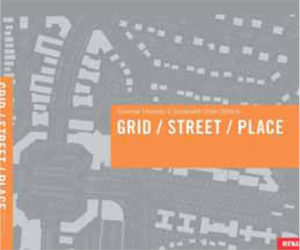Grid/Street/Place: Essential Elements of Sustainable Urban Districts, by Nathan Cherry with Kurt Nagle
Chicago: American Planning Association, 2009
In Grid/Street/Place, Nathan Cherry, Kurt Nagle and their collaborators pursue the ambitious goal of identifying, analyzing, and summarizing the key attributes of sustainable urban districts around the country. The book’s figure-ground diagrams, charts, perspectives, and photographs form a valuable resource, a worthy complement to the toolkit of any urban designer and architect who works at such a scale.
In the first two chapters, the authors lay the groundwork by presenting examples of both classic districts—Country Club Plaza in Kansas City, Mizner Park in Boca Raton, and Malaga Cove Plaza in Palos Verdes Estates and contemporary mixed-use districts, such as Playa Vista and L.A. Live in Los Angeles and Mockingbird Station in Dallas. They consider important elements of districts, such as squares, greens and parks, shopping streets, and “places” (reflecting a yet smaller scale).
The book’s restrained drawing style is applied with consistency and rigor. Detailed, same-scale diagrams nurture comparison, encouraging the reader to make back-and forth, page turning journeys. The diagrams document scale, open space, resources, transit, and general relationships of chosen districts, along with dimensionally accurate plans. The authors have the good sense to compress the district plans on one or two pages in each chapter, further enabling comparison. Each chapter includes a summary of findings and common attributes, and, although the text lacks literary flourish, one comes to appreciate the no-nonsense, “focus on the essentials” attitude.
The book betrays an unstated geographic bias in its selection of districts. As an Angeleno, it is a bias I appreciate and applaud. The authors choose a number of districts from the Los Angeles metropolitan area, which reflects their professional interests but is also a unique service to the region, considering the Southland’s enduring reputation as the front line of sprawl, lacking significant public spaces. L.A. is important, because it is not a bucolic environment, is very much a contributor to the global environmental crisis, and needs a toolkit of real solutions.
Early in the book, the authors discuss the necessity of using branding as a key part of the urban re- envisioning process, an approach that seems directly related to their professional expertise and is highlighted by a later chapter on “shopping streets”—a welcome chapter, given that retail design can be a very misunderstood topic dominated by specialists, and that it is not an area of deep expertise in most architectural offices.
If there is a less satisfying aspect to the book, it is the light touch on the topic of sustainability itself. While the chosen districts are clearly sustainable places, the attitude seems to be that their sustainability is self- evident, owing to their compact, mixed-use, and transit-oriented character. Yet this approach bypasses a critically focused discussion of sustainable performance, climate change, and other significant environmental pressures, none of which are in fact mentioned. In this area, the book is missing significant data and analysis, comparable to that applied to the physical characteristics and retail circumstances of the districts.
One would expect that performance in delivering solutions to greenhouse gas reduction, addressing stormwater needs, incorporating sustainable buildings, or reducing often excessive parking ratios (a potentially critical means to discouraging automobile use) would be central to the discussion. One could easily imagine highly aggressive performance indicators and checklists added to each chapter that analyze how the districts deliver on the critical global deadlines we face. This is the evolving core of professional practice. If there is one suggestion I would have, it is that the authors consider such issues in a revised version.
Originally published in arcCA 10.3, “Design Education.”






